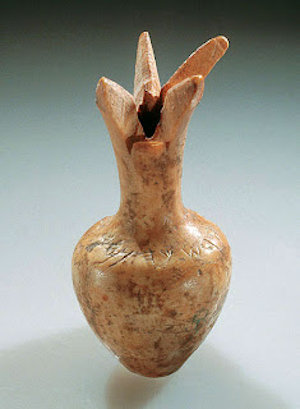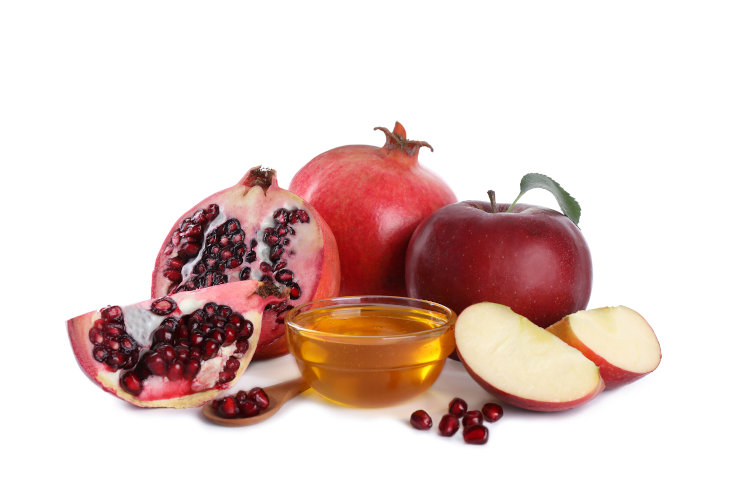 Iran’s Attack on Israel
Iran’s Attack on Israel


5 min read
These fruits have a long history in Jewish texts and are an important part of Rosh Hashanah.
Pomegranates are richly evocative in Jewish art, literature, and tradition. Mentioned throughout the Bible and Talmud, these sweet red fruits are often used to symbolize Jewish mitzvot (commandments) and are equated with plenty and good fortune. They’re particularly associated with Rosh Hashanah and wishes for a sweet new year.
Here are eight Jewish facts about this delicious fruit.
Pomegranates are one of the seven items of produce that are closely associated with the Land of Israel in the Bible. Before the Israelites entered the Land of Israel, they sent in a group of men to scout out the land. The men returned back to the Israelite camp with grapes, pomegranates and figs: samples of the wonderful fruits that grew in Israel (Numbers 13). Later on, when the Jews stood poised to enter the Land of Israel, Moses told them what to expect there. This time, pomegranates were part of a longer list of seven foods that are native to the Land of Israel and which represent its richness in the Bible: “a Land of wheat, barley, grape, fig and pomegranate; a Land of oil-olives and date-honey….” (Deuteronomy 8:8).
Even today, many places in present-day Israel are named for pomegranates (Rimonim in Hebrew): Ein Rimon (a natural preserve in southern Israel), Gat Rimon (a moshav, or collective farm, in central Israel), and Beit Rimon (a kibbutz, another type of mutually-owned collective farm, in the Galilee region of northern Israel) are a few examples.
 In some of the Bible’s most stirring descriptions of beauty, pomegranates are used as a metaphor for a woman’s comeliness. In King Solomon’s Song of Songs, the people of Israel are compared to a woman in love with her husband (representing the Divine). “Your brow behind your veil (gleams) like a pomegranate…” (Song of Songs 6:7).
In some of the Bible’s most stirring descriptions of beauty, pomegranates are used as a metaphor for a woman’s comeliness. In King Solomon’s Song of Songs, the people of Israel are compared to a woman in love with her husband (representing the Divine). “Your brow behind your veil (gleams) like a pomegranate…” (Song of Songs 6:7).
The Talmud, talking about a particularly attractive person, also reaches for a pomegranate metaphor, likening him to a goblet filled with ruby red pomegranate seeds in beauty (Baba Metzia 84a).
As anyone who’s ever cut open a pomegranate knows, this luscious fruit is filled with hundreds of tiny seeds. For millennia, Jews have used pomegranate’s copious numbers of seeds as a metaphor for the many commandments of the Torah.

The Talmudic rabbi Resh Lakish was one of the first to make this connection. Noting that Jews perform mitzvot, he said “Even the empty people among you are as full of mitzvot as the pomegranate is full of seeds” (Sanhedrin 37a).
In the days of the ancient Temples in Jerusalem, the Kohen Gadol - the High Priest who officiated in the Temple - wore a magnificent robe trimmed with 72 golden pomegranates (interspersed with 72 golden bells) hanging from the bottom of his robes (Exodus 34:34).
These echoed a row of carved pomegranates near the Temple’s massive carved pillars. The Bible describes the architecture of the First Temple, built by King Solomon: He made pillars, two rows going all around…to cover the capitals (the tops of the pillars)...with the pomegranates” (I Kings 7:18).
Even more than the juicy seeds, Jews have long prized the juice of pomegranates. In ancient times, it was used as dye for clothing and an ingredient in ink. Pomegranate molasses was also an important component in Jewish cooking: its tart, tangy sweetness imparted a distinctive flavor to many Jewish dishes, particularly in ancient times before lemons had reached the Middle East.
Cookbook writer and food historian Claudia Roden notes, “The thick dark-brown, almost black, syrup - also referred to as molasses - made from sour pomegranates is used by (Jewish) families from Syria, Iran, and Iraq for sweet=and-sour dishes….” (from The Book of Jewish Food: An Odyssey from Samarkand to New York With More than 800 Ashkenazi and Sephardi Recipes by Claudia Roden: 1996).
When Jews first settled outside the Land of Israel, they often took pomegranate seeds with them, planting them in their new homes. One such group of Jewish settlers established a town in southern Spain in ancient times. It’s not known today what this Jewish town called itself, but when Moors invaded the Iberian Peninsula in 711 CE, they stumbled upon this Jewish town and, seeing the Jews’ many pomegranate trees, bestowed an Arabic name on the settlement meaning pomegranate: Gharnata al Yahud - “Pomegranates of the Jews”. This name stuck, and in time evolved to Granada - a modern city that still flourishes in southern Spain today.
A motif of three pomegranates appeared on Jewish coins during the Hasmonean period. Even in modern times, a pomegranate appeared on the Israeli one-lira coins (used as Israeli currency from 1952-1980).

On Rosh Hashanah, Jews around the world make a beautiful blessing on pomegranates before they start their festive holiday meal. Since pomegranates, bursting with seeds, are associated with a life full to bursting with of mitzvot, it’s traditional to make a wish that our coming year will be as full as mitzvot and good deeds as a pomegranate is full of seeds, saying:
May it be Your will, Hashem, our God and the God of our forefathers, that our merits increase as (the seeds of) a pomegranate.

Some Jews also have the custom to eat pomegranates as a “new fruit”. It’s traditional to eat a fruit on Rosh Hashanah that one hasn’t eaten for at least a month. If you haven’t eaten pomegranates in a while, they make an ideal “new fruit” to enjoy at your Rosh Hashanah table. Before eating the new fruit, make the following blessing over new items and experiences:
Blessed are you, Hashem, our God, King of the universe, Who has kept us alive, sustained us, and brought us to this season.
Best wishes for a happy, healthy, and sweet new year!
